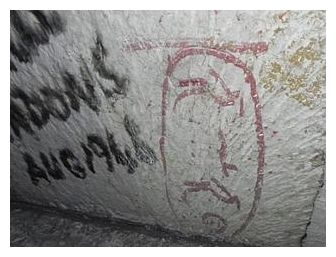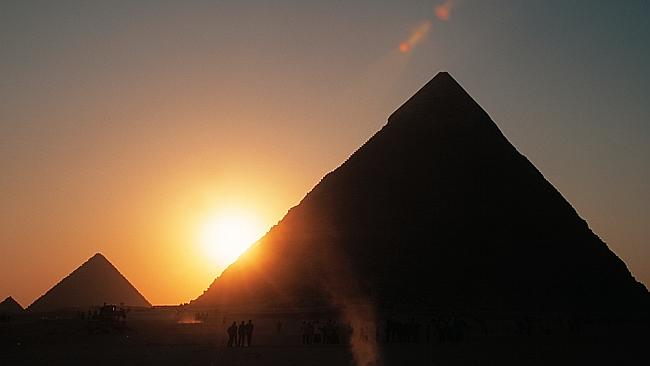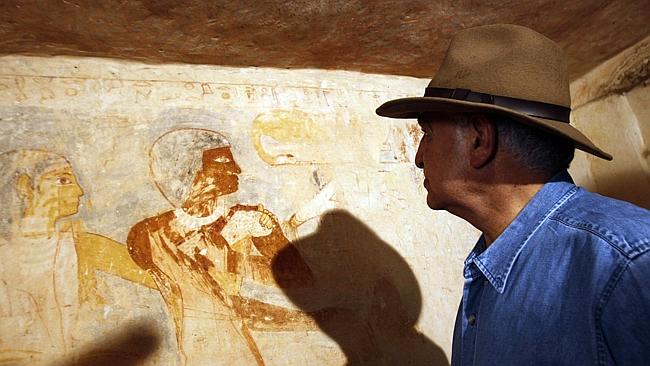
Supporters of the popular story that the Pyramids are evidence of a lost civilisation from the dawn of time consider the reaction all part of an ancient conspiracy.
Internet forums, books and doccumentaries all rage against the "old guard" for hiding the "truth" and refusing to take their ideas seriously. Now, they have a pair of Indiana-Jones style heroes: Two German students who stole into the Great Pyramid to scrape away at an ancient cartouche.
The painted cartouche which named Pharaoh Khufu (Cheops) is scrawled in a small compartment above his burial chamber in one of the three Great Pyramids at Giza.
Their idea is a popular one: That the Great Pyramids were merely "refurbished" by the Old Kingdom Pharaoh credited with its construction in the 26th Century BC. They argue the official dating of the Pyramids is solely based on the presence of the ancient red cartouche.
The two students from Dresden University recently took matters into their own hands: With Egypt's political turmoil distracting security forces, the pair conspired to sample the red paint and smuggle the pigment out of Egypt.
They have since asserted the fragments support arguments that the construction of date of the Pyramids was much older than Khufu's reign.
Accredited archaeologists dismiss the claim as a fanciful conspiracy theory.
"This is totally false and nonsensical," said Ahmed Saeed, professor of ancient Egyptian civilisation at Cairo University.

Professor Saeed said it was not certain that the ancient graffiti was written at the time of the pyramid's construction, though it is generally accepted it was put there in year 17 of Khufu's reign. However, it could have been scrawled there at any point in the following centuries as the tomb had been looted deep in antiquity, he said.
Mohamed Abdel Maqsoud, head of the ancient Egyptian department, asserted yesterday that more than two centuries of archeology had amassed a "multitude of scientific research" that irrefutably tied the Great Pyramids to King Khufu.
"A pyramid is not a sole object; it is part of a structural complex connected to each other. This includes the pyramid itself, the funerary temple, the side pyramid, solar boat pits, the ramp and the valley temple," Maqsoud wrote in a press release.
He pointed to the writings of Greek historian Herodotus who visited Egypt in the fifth century BC. He wrote of paintings on the ramp of Khufu's Pyramid which detailed scenes from the Pharaoh's era - including its construction. This ramp was disassembled and used to build nearby pyramids during the Middle Kingdom, but many of these blocks still contain Khufu's name.
Other evidence includes papyri diaries of engineers working on the pyramid's construction, records of trading expeditions to get the construction materials and the excavation of a massive nearby worker's camp where the builders resided.
"Lost Civilisation" proponents dismiss the above as merely evidence Pharaoh Khufu extensively renovated existing structures.
Believers point to a small set of largely discredited studies and amateur postulations, including claims by a geologist that erosion patterns "prove" the Pyramids and Great Sphinx belong to a much older "lost civilisation" from 20,000 years ago.

The German embassy in Cairo has issued a statement criticising the students' actions and reassured Egyptian authorities that they were not in any way associated with the German Archaeological Institute in an effort to avert any sanctions against the body.
Egypt's ministry of antiquities earlier this week condemned the action, saying it was a "great violation of Egypt's ancient heritage, and the great pyramid in particular - the only surviving monument of the seven wonders of the ancient world".
MSA minister Mohamed Ibrahim referred the case against the two Germans to the prosecutor-general for further investigation, alleging that both amateur archaeologists had broken Egyptian law by entering the pyramid and taking the samples without permission. Smuggling the pyramid material out of the country was also in breach of international law and UNESCO conventions relating to archeology, he said.
The students have been placed on an airport watch list and will be immediately arrested if they return to Egypt.



Reader Comments
to our Newsletter